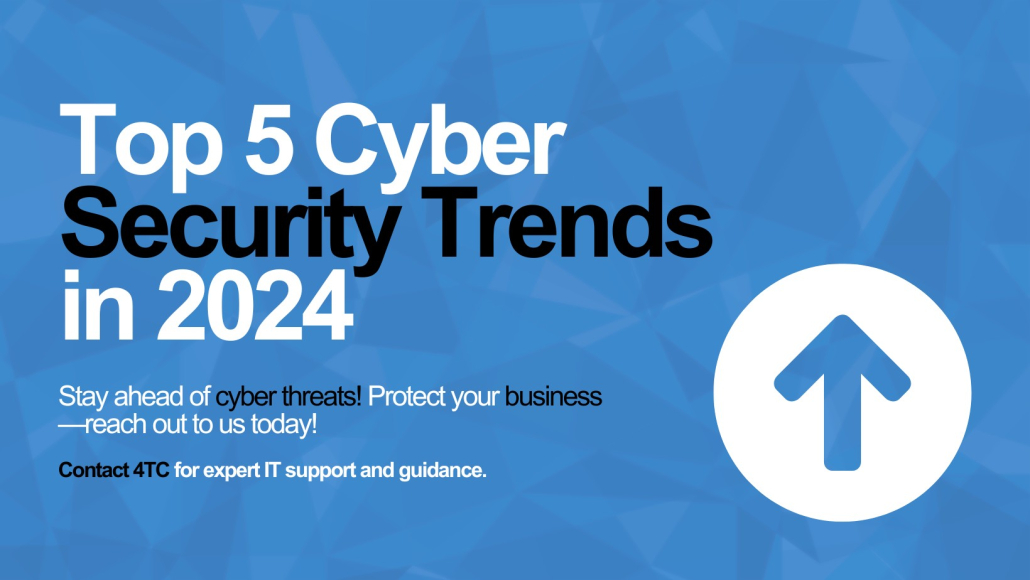Top 5 Cyber Security Trends in 2024
Across the UK, businesses are increasingly finding themselves in the crosshairs of sophisticated cyber threats. From AI-powered security measures to the growing concerns of supply chain vulnerabilities, 2024 is shaping up to be a pivotal year for cyber defence.
This blog explores the top cyber security trends that any business owner should be aware of. We’ll spare you the tech jargon and provide straightforward, practical advice on how to protect your business from emerging threats. Whether you’re a café owner in London or run an e-commerce site, these trends will help you stay one step ahead.
What Cyber Security Trends Have to Do with You
‘I’m not a cyber security business—why on earth should I care about this year’s trends?’—you, dubiously clicking on this article, probably. Regardless of your industry, cyber security affects every business. If you want to keep your team, assets, and reputation protected, staying up-to-date with cyber security trends is your best bet.
These trends, whether fleeting or long-lasting, can significantly impact your business operations. For instance, the types of cyber insurance policies available to you may change to account for new emerging cyber threats in the UK. Moreover, when your IT support team proposes new defensive measures, some background knowledge of the digital landscape will reassure you that they’re not just sales tactics but necessary updates to safeguard your business. Understanding what’s happening in cyber security, even a little bit, enables you to make informed decisions and prepare adequately for potential risks.
This Year’s Biggest Cyber Security Trends (So Far)
1. Integration of AI and ML into Cyber Security
The use of Artificial Intelligence (AI) and Machine Learning (ML) in cyber security isn’t new, but it has become more critical than ever in 2024. As Generative AI threats grow in complexity, businesses are increasingly deploying AI and ML to detect and respond to emerging cyber threats in the UK. These technologies help identify unusual patterns and respond to incidents faster than traditional methods.
2. Rise of Supply Chain Attacks
After trending downwards towards the end of last year, supply chain attacks are once again becoming a prominent cyber threat for small businesses. These attacks target third-party vendors or partners to infiltrate a primary business’s network. You might unknowingly download a compromised attachment for what you think is an invoice from a trusted supplier, which then grants a cyber criminal access to your systems and all your customer data. Or, you could become an unwitting participant in an attack on one of your clients if a hacker uses one of your team’s credentials to do the same to your customers.
Only one in ten UK businesses review the risk posed by their immediate suppliers, and even fewer than this look at their wider chain. With cyber criminals looking for any possible in, thorough vendor assessments and strong contractual security requirements are going to become a key consideration for SMBs moving forward.
3. Increased Reliance on IoT Devices
From smart speakers to security systems to heating, the proliferation of Internet of Things (IoT) devices has expanded the attack surface for businesses. As more companies integrate IoT into their operations, the need for securing these devices has become paramount. In the UK, it’s estimated that by the end of 2024, over 150 million IoT devices will be in use, with a significant portion connected to business networks. These devices, if not properly secured, can be exploited by cyber criminals to gain unauthorised access to sensitive information.
As the first country to formally ban easily-guessable default passwords on IoT devices, we’re leading the charge on improving the security of this cyber security trend. But, while it’s a big step in the way of common-sense prevention methods, this doesn’t mean SMBs can rest on their laurels. These devices still need proper configuration to keep your business secure, something IT service providers are adept at.
4. Growing Importance of Security Awareness Training
Security awareness training has gained traction as businesses recognise the human element as a critical factor in cyber security. A well-informed workforce can act as a first line of defence against cyber threats for small businesses,and it seems like more and more companies are becoming aware of this.
There’s been a 2% rise in the proportion of SMBs implementing training programs in the last year. Now, 30% of small businesses and 52% of medium organisations are taking steps to educate employees about recognising and responding to threats like phishing and social engineering. This proactive approach significantly reduces the likelihood of successful attacks stemming from human error.
5. Adoption of Continuous Threat Exposure Management
Continuous Threat Exposure Management (CTEM) is an emerging trend that involves regularly assessing and managing potential threats to business operations. Unlike traditional risk assessments conducted periodically, CTEM provides a real-time overview of vulnerabilities, enabling businesses to respond promptly to new threats.
After Gartner predicted that businesses using a CTEM program could see a two-thirds reduction in breaches by 2026, this approach is set to gain further popularity among those looking to stay ahead of emerging cyber threats in the UK.
How to Stay Ahead of Emerging Cyber Threats
Keeping up with cyber security trends involves proactive measures and continuous vigilance—which sounds like a considerable amount of effort, but once these protocols are in place, they’ll become just another part of your daily routines. Consider:
- Conducting Comprehensive Vendor Assessments: Regularly evaluate the security practices of third-party vendors and partners. Ensure they adhere to strict security standards to mitigate the risk of supply chain attacks.
- Investing in Advanced AI and ML Tools: Leverage AI and ML technologies to enhance threat detection and response capabilities. These tools can help identify unusual activities and automate responses to minimise damage and ease the increasing burden on your IT team.
- Securing IoT Devices: Implement robust security protocols for all IoT devices connected to your network. This includes regular firmware updates, strong authentication mechanisms, and network segmentation.
- Implementing Security Awareness Training: Regularly educate your employees about the latest cyber threats and best practices for avoiding them. This training should cover phishing, social engineering, and safe internet practices.
- Adopting Continuous Threat Exposure Management: Utilise CTEM to maintain a real-time view of your security posture. Regularly assess vulnerabilities and adjust your defences accordingly.
Check Out What’s Trending
In an environment where margins are often tight and resources are limited, being caught off-guard by emerging cyber threats in the UK can be devastating. By staying informed and adapting to the digital landscape, businesses can protect themselves more effectively and ensure their continued success. Rather than being overwhelmed by the challenges, consider these trends as opportunities to strengthen your cyber security posture and safeguard your business’s future.
There are plenty of ways you can stay updated on the latest cyber security trends—we’d recommend following our socials and checking out our blog to get started.
Secure Your Small Business With 4TC – Expert IT Support for London and the Southeast
We offer flexible, forward-thinking IT solutions to small and medium-sized businesses from our offices in London and Essex—but a partnership with us provides more than that.
The 4TC team prides itself on developing long-term relationships that add value to your business with high quality managed support, expert strategic advice, and professional project management.
Ready to make cyber security a priority? We’d be happy to share our wisdom. Get in touch using our contact form today!





